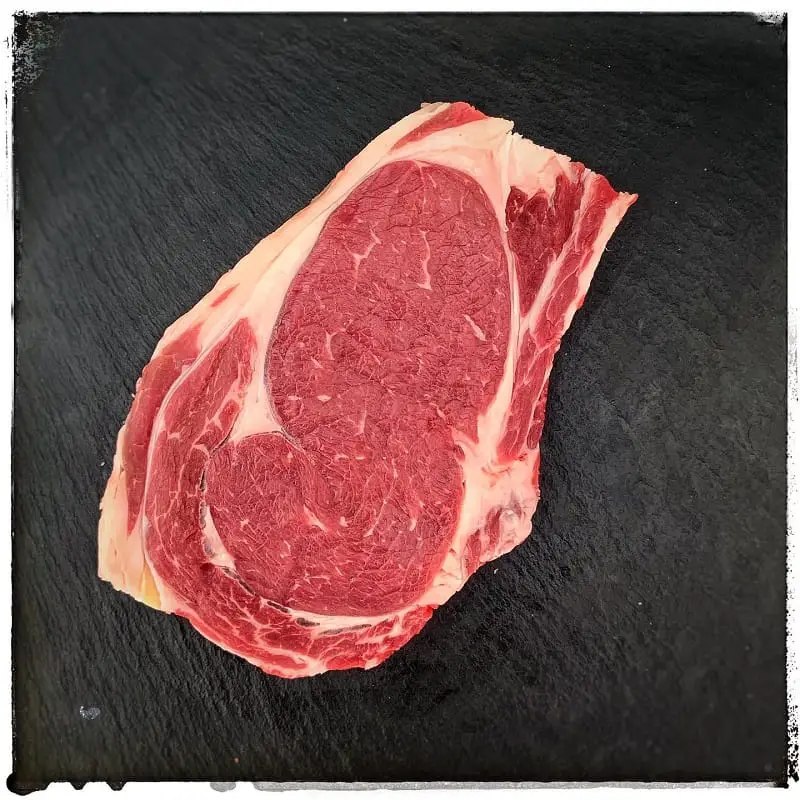There are few things as satisfying as a perfectly cooked, juicy steak. A delicious cut of meat, cooked to perfection, not only tantalizes the taste buds but warms the soul. And while there are many different cuts of beef, two stand out for their unparalleled taste and tenderness: Delmonico and Ribeye. These two esteemed steaks share much in common but are not entirely interchangeable. There are a handful of differences worth considering for steak enthusiasts trying to decide the winner of the age-old battle – Delmonico Vs Ribeye.
In this article, we will explore the origins, characteristics, and taste profiles of these two exceptional cuts of beef, as well as the best ways to cook and serve them. So, if you’re a meat lover looking to learn more about Delmonico and Ribeye steaks, grab your apron, fire up the grill, and join us for a mouthwatering culinary journey.
What Is The Main Difference Between Delmonico Vs Ribeye Steak?

Delmonico and ribeye steaks are two popular and delicious cuts of beef with unique characteristics that make them stand out.
The main difference between the two lies in their origin. Ribeye steak comes from the sixth to the twelfth rib of the cow and is boneless, renowned for its rich flavor and extensive marbling. In contrast, Delmonico steak comes from different parts of the cow and may be cut between the shoulder and the short loin, with bone-in or boneless options available. It is often tough and lean and can be labeled under different names, such as New York strip steak or Kansas City strip steak, depending on the region. Ribeye steak tends to be more expensive, while Delmonico is more affordable.
- Names: Delmonico Steak got its name from a famous restaurant in New York City called Delmonico’s. On the other hand, Ribeye steak is also known by different names in different places like rib steak or Spencer steak in some states, and as Scotch fillet in New Zealand and Australia.
- Appearance: Delmonico steak is typically cut from the cow’s rib section, while Ribeye steak is cut from the rib primal, which is closer to the shoulder. Delmonico steak has a more uniform, rectangular shape compared to Ribeye steak, which has a distinctive oval shape due to the presence of the rib bone. Delmonico steak also tends to have slightly less marbling than Ribeye steak, which can make it appear slightly leaner. In terms of color, both cuts are typically a deep red color, but the slightly thicker cut of Delmonico steak can sometimes result in a slightly darker hue.
- Meat cut: Delmonico Steak There is no consensus on which specific cut of meat is called a Delmonico steak, and it can be sourced from various parts of the cow, including the shoulder, sirloin, top loin, short loin, rib, and chuck. On the other hand, Ribeye steak is a beef cut retrieved from the sixth to the twelfth rib of the cow. It is a boneless cut renowned for its extensive, rich flavor due to the fat integrated into the muscle.
- Cooking techniques: Ribeye steak is known for its highly visible marbling, which is the fat that runs through the steak. This marbling makes for a rich, buttery flavor and tender texture, making it a favorite for grilling and searing. In contrast, Delmonico steak can benefit from marinating and slower cooking methods, such as braising, to break down the meat and enhance its flavor.
- Texture: Ribeye steak is known for its tender and smooth texture since it comes from the less-exercised rib section of a cow. This section has less connective tissue, resulting in easier-to-chew meat. On the other hand, Delmonico steak comes from the chuck section of the cow, which covers the shoulder region. This area has more connective tissues and a tougher texture.
- Taste: Ribeye has a rich buttery flavor with highly visible marbling that gives it a tender and juicy texture. On the other hand, Delmonico steak has an intensely beefy flavor reminiscent of rustic beef steaks. While it may not have as much marbling as ribeye, Delmonico steak is known for being exceptionally tender and juicy due to its generous fat content.
- Bones: Delmonico steak can come with or without bones. The bone-in version of Delmonico steak is often referred to as a “Delmonico ribeye.” On the other hand, ribeye steak is always boneless.
- Price: Ribeye is a highly prized cut of beef and is expensive at around $10-$12 per pound. On the other hand, Delmonico steak is considerably cheaper, making it a more affordable option for consumers. The price difference is due to the amount of marbling in the meat. Ribeye has more fat integrated into the meat’s muscle, making it tender and buttery when cooked.
- Availability: When it comes to availability, ribeye steak is more widely available than Delmonico steak. This is because ribeye steak is a well-known beef cut readily available at most grocery stores and restaurants. On the other hand, Delmonico steak can be harder to find as no consistent definition or cut of meat is associated with the name.
Read more:
- Cowboy Steak Vs Tomahawk
- T Bone Vs Ribeye
- Ribeye vs Porterhouse
- Prime Vs Choice Vs Select
- New York Strip Vs Ribeye
- Spare Ribs vs Short Ribs
- Ribeye Vs Tenderloin
- How Long To Smoke Country Style Ribs At 225
Which is Healthier: Delmonico Vs Ribeye?
Delmonico and ribeye steak have no significant difference in nutritional value. Both cuts of beef provide similar amounts of protein, vitamins, and minerals. However, it is important to consider the fat content of each steak. Ribeye steak contains more visible fat, which can contribute to higher calorie and saturated fat intake. On the other hand, Delmonico steak has less visible fat content, making it a slightly healthier option.
Ultimately, the healthiest way to prepare these steaks is to trim excess fat and cook them using healthy cooking methods such as grilling or broiling. Consuming these types of meat in moderation is also recommended as part of a balanced diet.
What is Delmonico?

Delmonico steak is a boneless cut of beef taken from the cow’s rib section. It is known for its tender texture and rich flavor, which makes it a favorite among steak enthusiasts.
The history of Delmonico steak dates back to the 19th century when it was first introduced by the famous Delmonico’s restaurant in New York City. The restaurant, founded in 1827, was known for its luxurious atmosphere and innovative cuisine. It was a favorite among the upper class and served as a meeting place for politicians, business people, and socialites.
Today, the Delmonico steak is still a popular dish in many high-end restaurants worldwide. It is typically cooked using dry-heat methods such as grilling, broiling, or pan-searing. The steak is often served with various sides, including mashed potatoes, roasted vegetables, and a red wine sauce.
What is Ribeye?

Ribeye is a beef cut from the cow’s rib section. It is known for its marbling, which is the fat that is laced throughout the meat. This marbling gives the Ribeye its distinct flavor and tenderness.
When it comes to cooking Ribeye, various options are available. You can grill, pan-sear, broil, or even roast it. It all depends on your personal preference and the equipment you have at your disposal.
But what sets Ribeye apart from other cuts of beef is its versatility. You can serve it as a steak, use it in stir-fry dishes, or even chop it up for a delicious beef stroganoff. The possibilities are endless.
However, it’s important to note that Ribeye is not the healthiest cut of meat out there. Due to its high-fat content, it can be quite calorie-dense. So, if you want to watch your waistline, it’s consuming Ribeye in moderation is best.
Are There Any Similarities In Taste And Texture Between Delmonico And Ribeye?

Delmonico and Ribeye steaks are premium beef cuts known for their delicious taste and juicy texture. Despite some differences in fat content and marbling, the two have quite a few similarities in taste and texture. Both cuts are taken from the cow’s rib section and have an intense beefy flavor. They are both quite tender, with Delmonico having a slightly smoother texture and Ribeye offering more chew. Both cuts of steak are high in protein and contain significant amounts of vitamin B12.
Delmonico and Ribeye steaks can be cooked similarly, with grilling and broiling being popular methods to bring out their delectable flavors. While there are some differences in how these steaks are prepared and served, Delmonico and Ribeye are similar in their exceptional taste and texture.
What Are Some Popular Seasoning Or Marinade Options For Delmonico And Ribeye Steaks?
Seasoning is one of the most important aspects of any dish. Whether cooking a simple meal or an elaborate feast, the right seasoning can take your dish from good to great. Here, I want to share some of my favorite seasoning options popular in the culinary world.
- Let’s start with salt – the most basic seasoning in every kitchen. It’s a reliable way to enhance flavor and bring out the natural taste of your food. However, not all salt is created equal. Kosher salt is a popular choice among chefs as it has larger crystals that dissolve easily and provide a nice crunch. Sea salt is another great option for those who want a more intense flavor.
- Next up, black pepper. This is another staple in most kitchens and for good reason. Black pepper adds a spicy kick to your dishes and is versatile enough for savory and sweet dishes. Try using whole peppercorns and grind them for a more robust flavor.
- Garlic is another seasoning that can be found in almost every kitchen. It has a strong, pungent flavor that can transform any dish. You can use fresh garlic or garlic powder, depending on your preference. It’s important to note that fresh garlic is milder than garlic powder, so adjust your usage accordingly.
- Cumin is a popular spice used in many cuisines around the world. It has a warm, earthy flavor that pairs well with meat, vegetables, and grains. Cumin is often used in chili, curries, and taco seasoning.
- Paprika is a mild spice that adds a beautiful red color to your dishes. It has a sweet, smoky flavor, perfect for seasoning meats and vegetables. Paprika is often used in Hungarian cuisine and is a key ingredient in goulash.
- Lastly, let’s talk about herbs. Herbs are a great way to add freshness to your dishes. Some popular herbs include basil, oregano, thyme, and rosemary. Fresh herbs are always preferred, but dried herbs will also do the job.
Factors to Consider When to Choose the Best Delmonico and Ribeye Steak
- Marbling: Look for good marbling in the ribeye steak as it will ensure tenderness and flavor. Marbling looks like white flecks of fat on the meat, and the higher the amount, the better the cut of meat.
- USDA Grades: Consider the USDA grades assigned to the ribeye steak to pick the best one. Prime is the highest grade, followed by Choice and Select.
- Cut: Opt for a middle cut of ribeye steak, as it is the most tender. Cuts from the end tend to be tougher and have a rougher texture.
- Grass-fed vs. Grain-fed: Choose grass-fed ribeye steak as it is leaner, has a more complex flavor profile, and contains higher Omega-3s fatty acids and Vitamins A and E.
- Cooking Method: Choose a ribeye steak grade based on the cooking method. Prime cuts are best suited for dry heat methods like roasting, frying, and grilling, while choice cuts can be braised or roasted. Select cuts are leaner and better suited for moist-heat cooking methods.
FAQs
What Is The USDA Grading For Delmonico And Ribeye Steaks?

The Delmonico steak is a luxurious bone-in steak derived from the area between the ribeye and New York strip. It is hand-cut to a generous thickness and sourced from the top 4% beef graded to the USDA’s standards. This steak has the richness of a ribeye with the firm texture of a strip steak and is left attached to the rib bone for a high-end dining experience. The USDA Prime Delmonico is a rare and special steak, with only two available from each head of cattle. Ribeye steaks are also graded based on their marbling and age, with Prime being the highest quality grade available.
Can Both Delmonico And Ribeye Steaks Be Grilled?
Yes, both Delmonico steaks and ribeye steaks can be grilled. However, it’s important to note that Delmonico steaks, being thicker and heavier, may not always render their flavor content as effectively when grilled.
Can These Steaks Be Cooked In A Pan Instead Of On A Grill?
Absolutely! Both Delmonico and ribeye steaks can be cooked in a commercial kitchen by pan-searing them. This method allows for a deliciously seared crust and a juicy interior.
What Is The Recommended Cooking Temperature For Delmonico And Ribeye Steaks?
When preparing Delmonico and ribeye steaks, cooking them to a specific temperature is recommended for the best results. A rare steak should have an internal temperature of 120 to 125 degrees Fahrenheit, while medium-rare to medium doneness is achieved at 130 to 150 degrees Fahrenheit. It is important to use an instant-read thermometer to check the doneness, especially since cooking time varies based on the steak’s thickness and the grill’s heat.
A well-done steak, with an internal temperature above 150 degrees Fahrenheit, is not desirable for a really good steak. After cooking, it is important to let the steak rest for five minutes, as it will continue to cook as it sits and distributes heat evenly.
Verdict: Which is Better – Delmonico vs Ribeye Steak?
In conclusion, the Delmonico and the Ribeye are fantastic cuts of beef that will satisfy any steak lover’s cravings. Whether you prefer a firmer texture or a softer one, a rich flavor or a juicy one, there’s a cut out there that’s perfect for you. So next time you’re at the butcher, consider trying one of these delicious cuts. You won’t be disappointed!
We hope this post has been helpful in answering the question of Delmonico vs Ribeye Steak. Let us know how it turns out by leaving a comment below.
References:
- https://www.charbroil.com/how-tos/understanding-usda-steak-grades-for-grilling
- https://www.mashed.com/669255/what-is-delmonico-steak-and-is-it-better-than-ribeye/
- https://abcnews.go.com/abcnewsnow/GMANow/story?id=6402436&page=1

Hey there, it’s Maura Braun from Maura’s Kitchen of Millbrook! If you love all things BBQ and grilling, my blog is the perfect place for you. But my passion for food doesn’t stop at the restaurant. I also love sharing my smoker, grilling, and BBQ experiences on my blog. From juicy brisket to perfectly smoked ribs, I’m always experimenting with new techniques and flavor combinations.

Delmonicos: Just call it a ribeye…
In my opinion, I believed that Delmonicos were located towards the Chuck part of the beef, while Ribeyes were situated at the opposite end of the same meat cut.
Now I’m on a mission to find the juiciest Delmonico steak ever. Any recommendations?
You broke down the differences between Delmonico and Ribeye in a way that even a steak novice like me could understand. My inner meat aficionado thanks you!
I don’t know about you, but my mouth is watering just thinking about those perfectly marbled ribeyes.